Political Cartoon Transcontinental Railroad Funny Political Cartoons Transcontinental Railroad
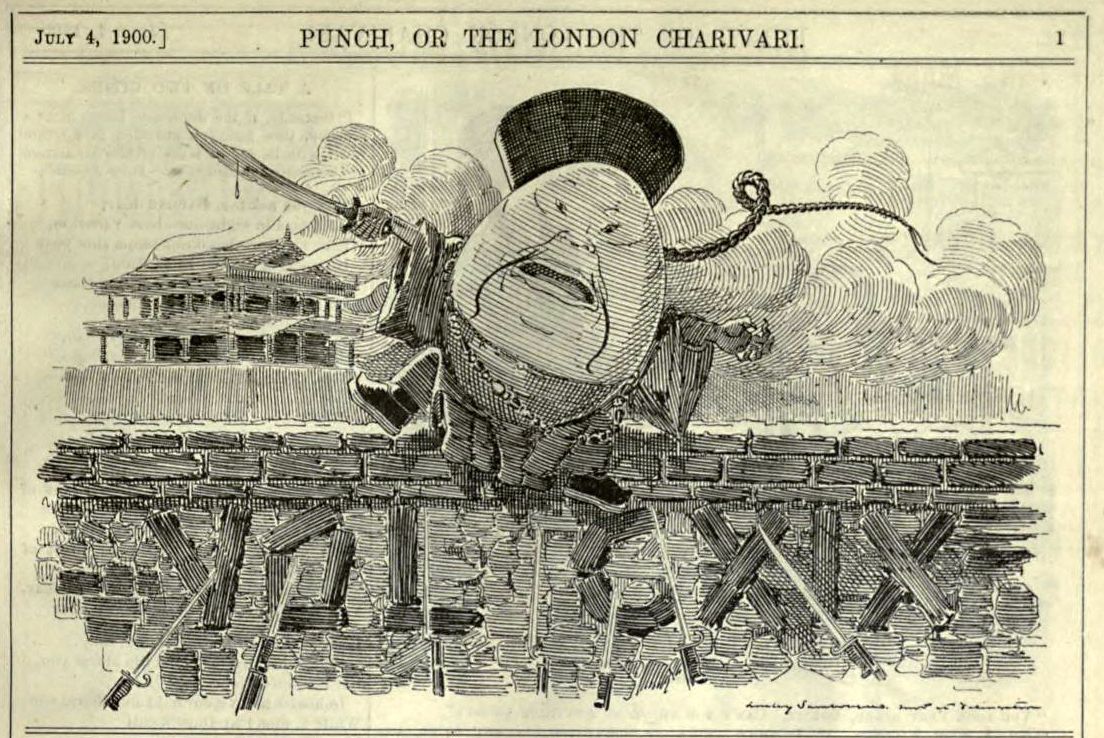 | ||
| China in crisis—flames behind, bayonets in the foreground—is depicted as the egg poised to fall in the English nursery rhyme: Humpty Dumpty sat on a wall, Punch, or the London Charivari, July 4, 1900 | ||
| CARVING UP CHINA In the late-nineteenth century, the major imperial powers competed more aggressively for domination of most of the world's territory. Railroads supported increasing penetration of remote regions, and the telegraph rapidly communicated one nation's victory to others around the world. The first durable trans-Atlantic telegraph cable, laid in 1866, connected the New and Old Worlds with a rapid communication link. The opening of the Suez canal in 1869 dramatically shortened the route to the Far East, just as the U.S. completed the transcontinental railroad. As regions of the Ottoman empire loosened their dependence on the center, the French, British, and Russians looked to expand their influence. Each imperial power felt that it had to defend its own territories and pre-empt the moves of others. The "Scramble for Africa," touched off in 1882 by the submission of the ruler of Tunis to a French resident, was followed by British intervention to secure its financial investments in Egypt. Over the next twenty years British, French, Belgian, and German troops, explorers, and investors carved up nearly all of the African continent. In the 1890s, the global scramble expanded to Asia, and new powers joined the race. Japan's defeat of China in the Sino-Japanese war in 1895 put Taiwan and Korea under its control, starting its road to become the next imperialist in Asia. The United States joined the pack of genuine imperial powers with its victory in the Spanish-American War of 1898, adding Cuba, Puerto Rico, and the Philippines to the list of colonial possessions. Russia, turning eastward, began building the trans-Siberian railroad in 1891 to connect its Asian regions closely to Moscow. The railroad reached the port of Vladivostok (meaning "Ruler in the East") in 1916. Russia's turn to the East inevitably brought it into conflict with the rival powers of northeast Asia: China, Korea, and Japan. As Britain and Russia competed in the "Great Game" for power over Central Asia, Britain allied with Japan in 1902 to balance Russian expansion. The multipower scramble for China, from 1895 to 1905, followed a similar pattern to that of Africa, but with very different results. Japan's surprising defeat of the Qing empire instigated all the powers to secure spheres of influence connected to their economic interests, and fears of "slicing the Chinese cake" increased. Many writers predicted the imminent breakup of the empire into regions, each dominated by one imperial power. The four images below exhibit variants of the metaphor of the slicing of China, representing critiques from French, American, and British perspectives. |
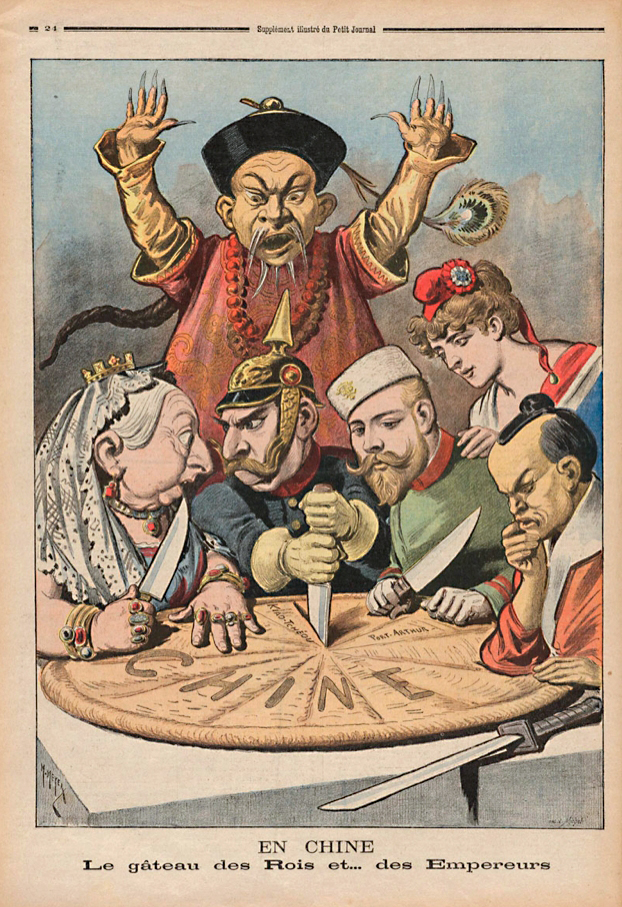 | ||
| "En Chine: Le gâteau des Rois et... des Empereurs" Le Petit Journal Supplément Illustré, January 16, 1898 Artist: H. Meyer In this French rendering, Queen Victoria glares at the German Kaiser, while the Russian, French, and Japanese figures look pensively at China. The Kaiser stabs his knife into the German-leased territory Jiaozhou (Kiao-Tcheou) in Shandong, acquired in 1898, while the Russian Tsar puts his fists on Port Arthur (the Chinese port of Lüshun, leased in 1897). The caption reads: "China: The cake of Kings and Emperors." | ||
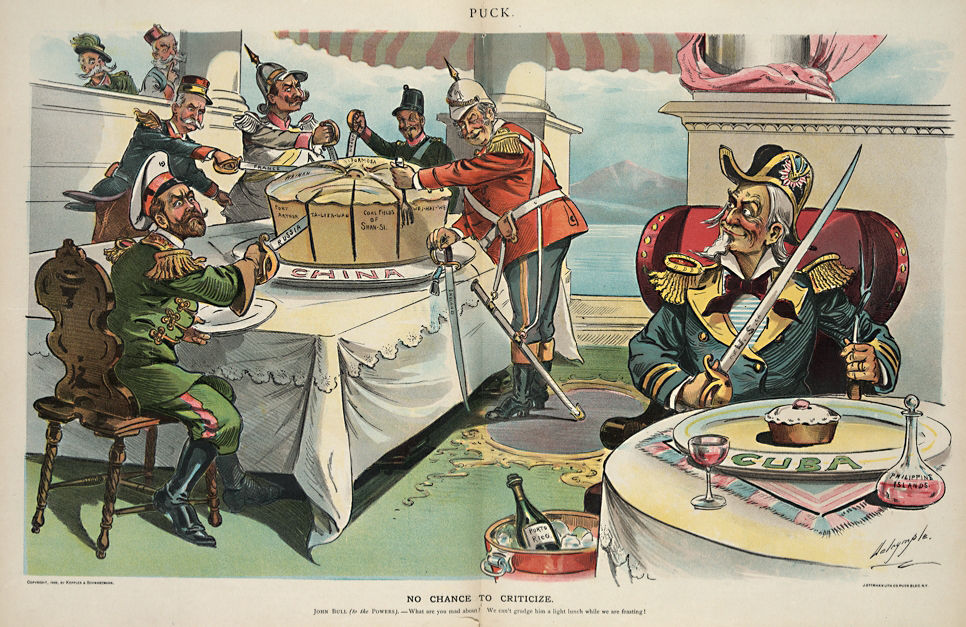
| "No Chance to Criticize." Caption: "John Bull (to the Powers). — What are you mad about? We can't grudge him a light lunch while we are feasting!" Puck, May 25, 1898 Artist: Louis Dalrymple |
| Puck, the American counterpart to the famous British humor magazine Punch, sardonically juxtaposed U.S. expansion in and immediately after the Spanish-American War of 1898 against the contemporaneous scramble by other imperialist powers to carve up China. As in the French cartoon, Russia, France, Germany, Japan, and England slice the Chinese cake, but the not-so-subtle point of this cartoon was that while the United States self-righteously criticized the foreign scramble for spheres of influence in China and called for an "Open Door" policy there, it was in the process of establishing its own spheres of influence in the Caribbean and the Philippines. [puck_1898_May25_CarveCh_loc] |
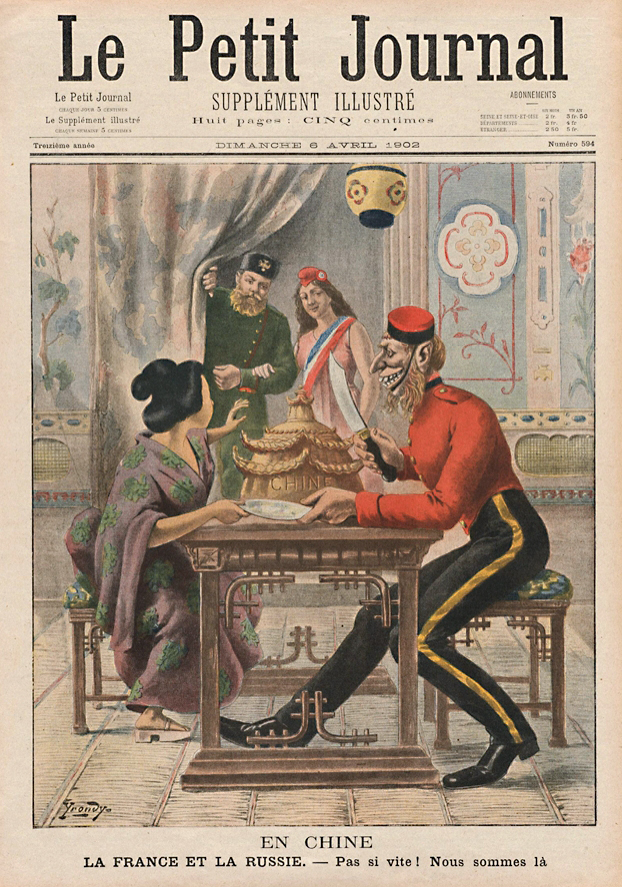
| "En Chine" (In China) Caption: "La France et La Russie. — Pas si vite! Nous sommes là" (France and Russia: Not so fast! We're here") Le Petit Journal Supplément Illustré No. 594, April 6, 1902 In the foreground England and Japan, who had just negotiated the Anglo-Japanese alliance in 1902, find themselves surprised by Russia and France, who claim equal rights in slicing the Chinese cake. |
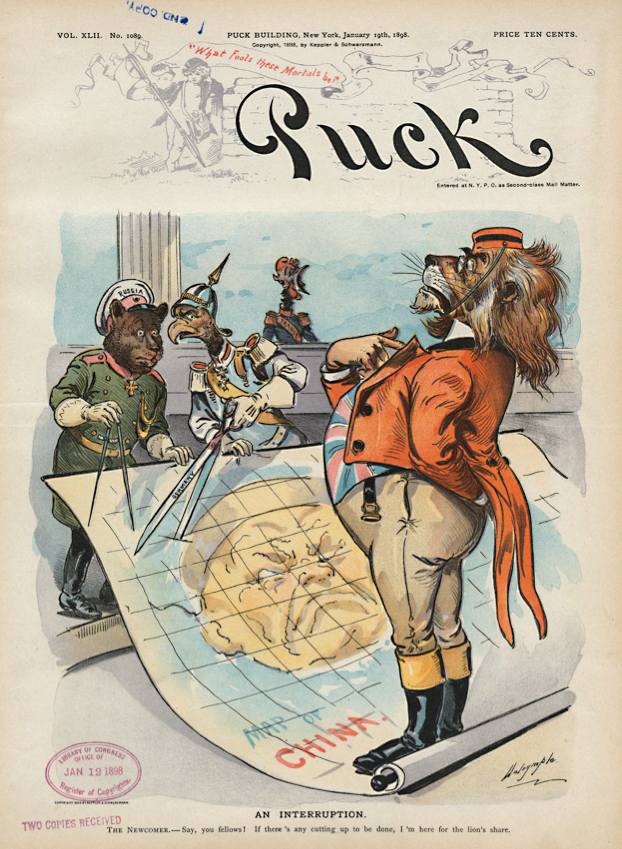
| "An Interruption." Caption: "The Newcomer. — Say, you fellows! If there's any cutting up to be done, I'm here for the lion's share." Puck, January 19, 1898 Artist: Louis Dalrymple In this cartoon, Britain, which held the dominant position in spheres of influence in China, confronts the rival claims of Russia and Germany, while the French cock squawks in the rear. Source: Library of Congress (view) |
| From the satirical realm of cartoons, we turn to apparently more neutral cartographic commentary. Two maps published in Harper's Weekly in 1900 graphically depict the imperialist rivalries and tensions that accompanied the carving up of China. One is a "forecast" of Russian, German, British, French, Japanese, and Italian spheres of influence in the beleaguered country. The second highlights the strategic significance of the U.S. conquest and colonization of the Philippines in 1899–1900, which placed America at "the geographical centre of the Oriental commercial field." The anxiety over China's partition shown in these two maps helps to explain why U.S. foreign policy called for an "open door" in China, in which all foreign powers had equal rights to exploit China's territory, without reserved spheres of influence. |
| "A Forecast of the Partition of China" This "forecast" was roughly accurate, although in the end Italy did not establish a sphere in China. | 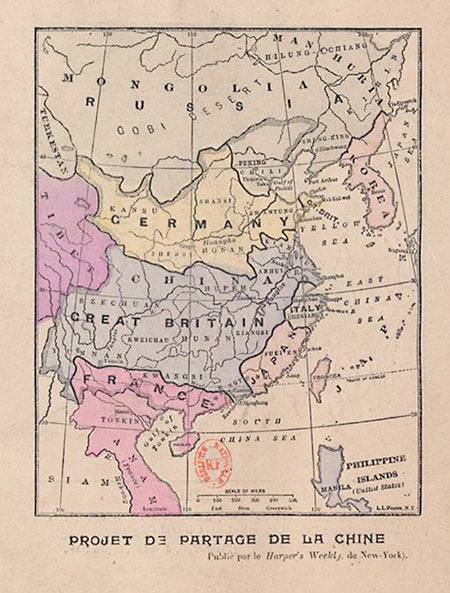 |
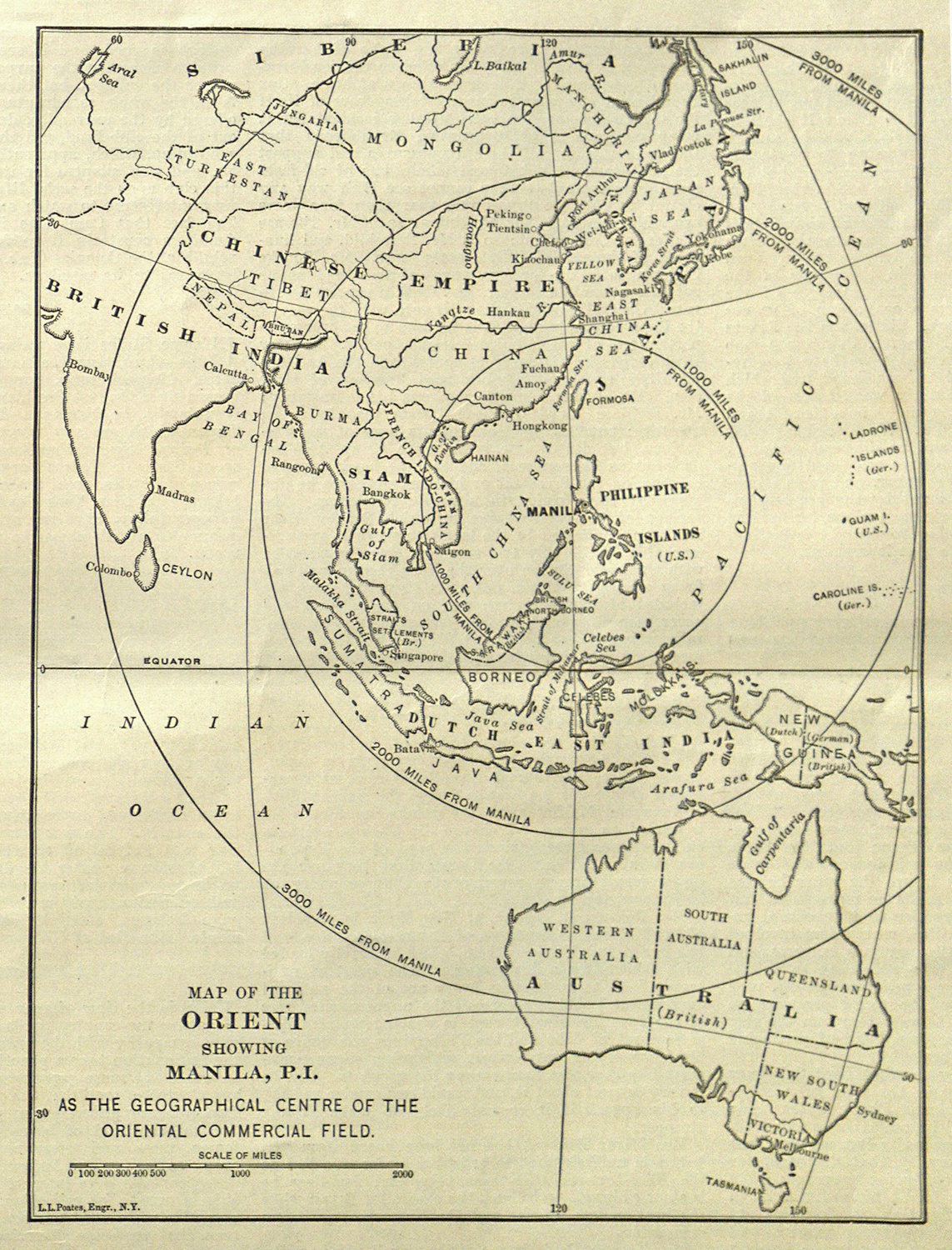
| "Map of the Orient showing Manila, P.I. as the Geographical Centre of the Oriental Commercial Field." Harper's Weekly, ca. 1900 This map, published in New York, puts Manila close to the center, indicating the strategic location of the Philippines for U.S. commercial interests in all of Asia. |
| As it happened, the push to carve China into foreign spheres of interest coincided with a revolutionary transformation in the nature of international communication. Advances in telegraph transmission expedited the speed of journalistic reporting. At the same time—and more vivid and dramatic—the turn of the century saw a great leap forward in color printing. The lavish political cartoons in illustrated periodicals such as Punch in England and Puck and Judge in the United States are classic examples of this explosion in dramatic, colorful political commentary. They had counterparts, moreover, throughout Europe. Abetting this technological transformation was the emergence of international postal regulations that facilitated the global dissemination of picture postcards. Images produced in one country were frequently reproduced for a global audience—sometimes so quickly that the original place of origin became obscured. Naturally, this heightened popular awareness of international affairs. Beyond this, it also stimulated international give-and-take in the form of graphic replication, imitation, adaptation, and even outright parody. A particularly colorful example of this new world of pictorial global sharing was a bilingual English and Chinese political map of foreign encroachment on China at the time of the Boxer uprising. Of uncertain origin, this was disseminated in several variations. The colloquial correctness of English notations on the map make some kind of British-Chinese collaboration plausible, and one version—reproduced in the American magazine Leslie's Weekly in 1900—assigns authorship to a Chinese artist in Hong Kong in July 1899. The most sophisticated and often reproduced rendering of this elaborate geopolitical commentary—replete with the Russian bear, British lion, American eagle, French frog, Japanese rising sun, and caricatures of the Chinese—bears a bold border of Chinese ideographs. Clearly, this was directed to Chinese (and possibly Japanese) audiences. |
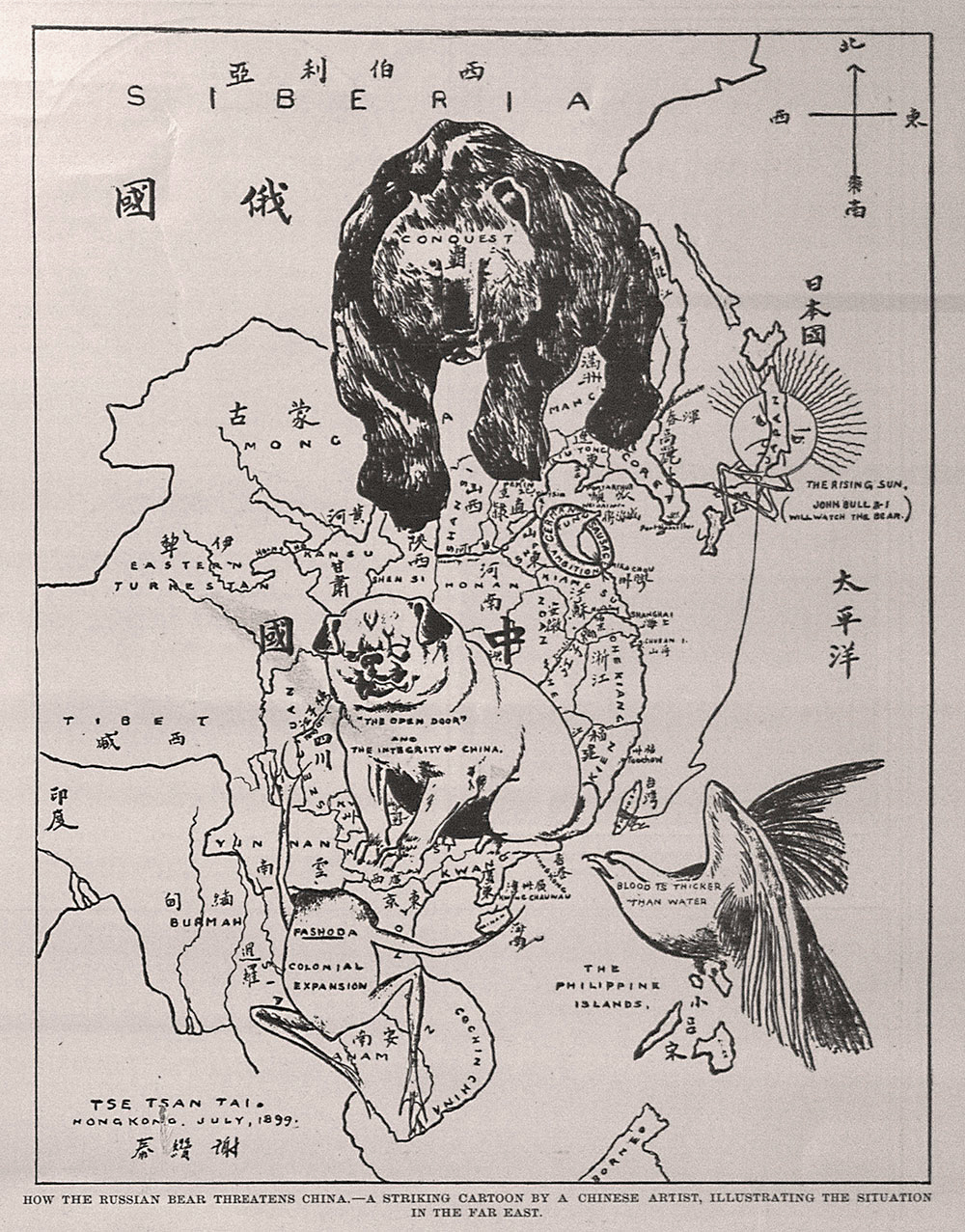
| "How the Russian bear threatens China. — A striking cartoon by a Chinese artist, illustrating the situation in the Far East." Leslie's Weekly, ca. 1900 [leslies_1900_v92_1_023_animal_map_detail] |
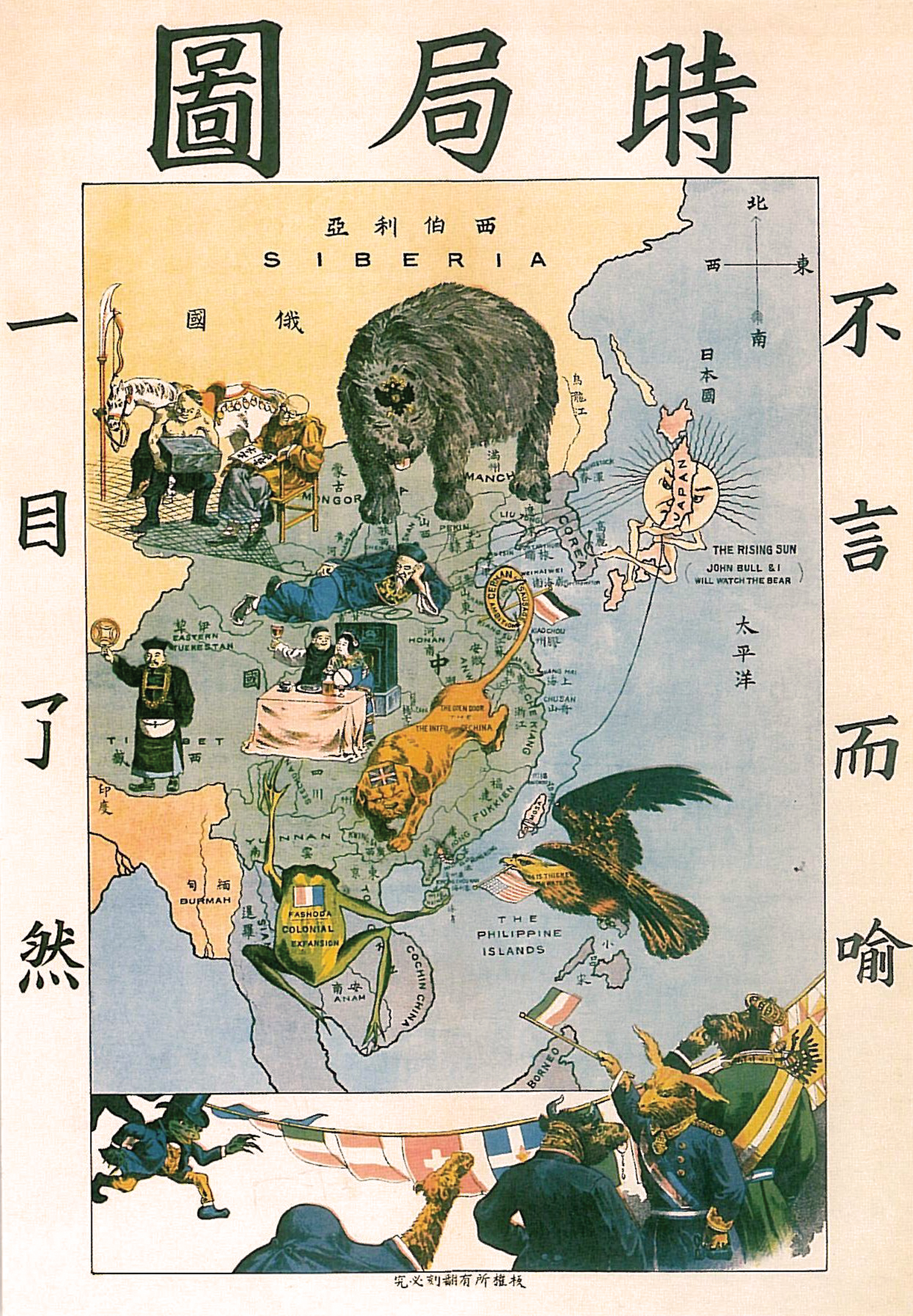
| "The Situation in the Far East" Political map of 19th-century China, ca. 1902–1903 |
| This graphic rendering of the political map of China probably dates from ca. 1902–1903. The bold lettering in the borders reads "Picture of Current Times" (top), "Obvious in One Glance" (left), and "It Speaks for Itself" (right). The Russian bear approaches from Siberia. Japan, which would go to war with Russia in 1904, is identified as "The Rising Sun" and accompanied by a parenthetical declaration that "John Bull & I will watch the bear." (A reference to the Anglo-Japanese Alliance of 1902.) England—here depicted as a lion (rather than the bulldog on the 1899 map)—sinks its claws into south China, while a circular sausage with the legend "German Sausage Ambitions" surrounds Shandong. The American eagle, approaching from the Philippines, bears the quotation "Blood is thicker than water," a famous comment made by a U.S. admiral in 1859 indicating that the U.S. would side with Britain in the Second Opium War. France, depicted as a frog, is ensconced in Southeast Asia and reaches toward China, with the words "Fashoda: Colonial Expansion" on its back, referring to the clash between British and French troops in East Africa in 1898. The Chinese figures (which do not appear on the 1899 version of the map) depict Manchu soldiers, coolie laborers, sleeping officials, and literati carousing with mistresses while the wild beasts prowl. |
| Race, Religion, & the "Yellow Peril" In 1895, at the very moment that Japan was inflicting a stunning military defeat on Qing China, Kaiser Wilhelm II of Germany popularized a soon notorious phrase: the gelbe Gefahr, or "Yellow Peril." This reflected alarm not just at Japan's unexpected military prowess, but at the broader specter of non-White, non-Christian Asian peoples emerging to challenge the Western world. A lithograph of this imagined threat, based on a drawing by the Kaiser, was produced that same year by a German artist whom he favored. It attracted worldwide attention. In this, the archangel Michael, holding a flaming sword, stands before a host of female warriors personifying the nations of Europe. He points to a distant Buddha wreathed in flames against black thunderclouds—or, in some interpretations, the black smoke of a burning village. The Christian cross shines in the sky above the imperiled Westerners. The original lithograph carried a handwritten caption, allegedly written by Wilhelm, exclaiming "Peoples of Europe, defend your holiest possessions!" |
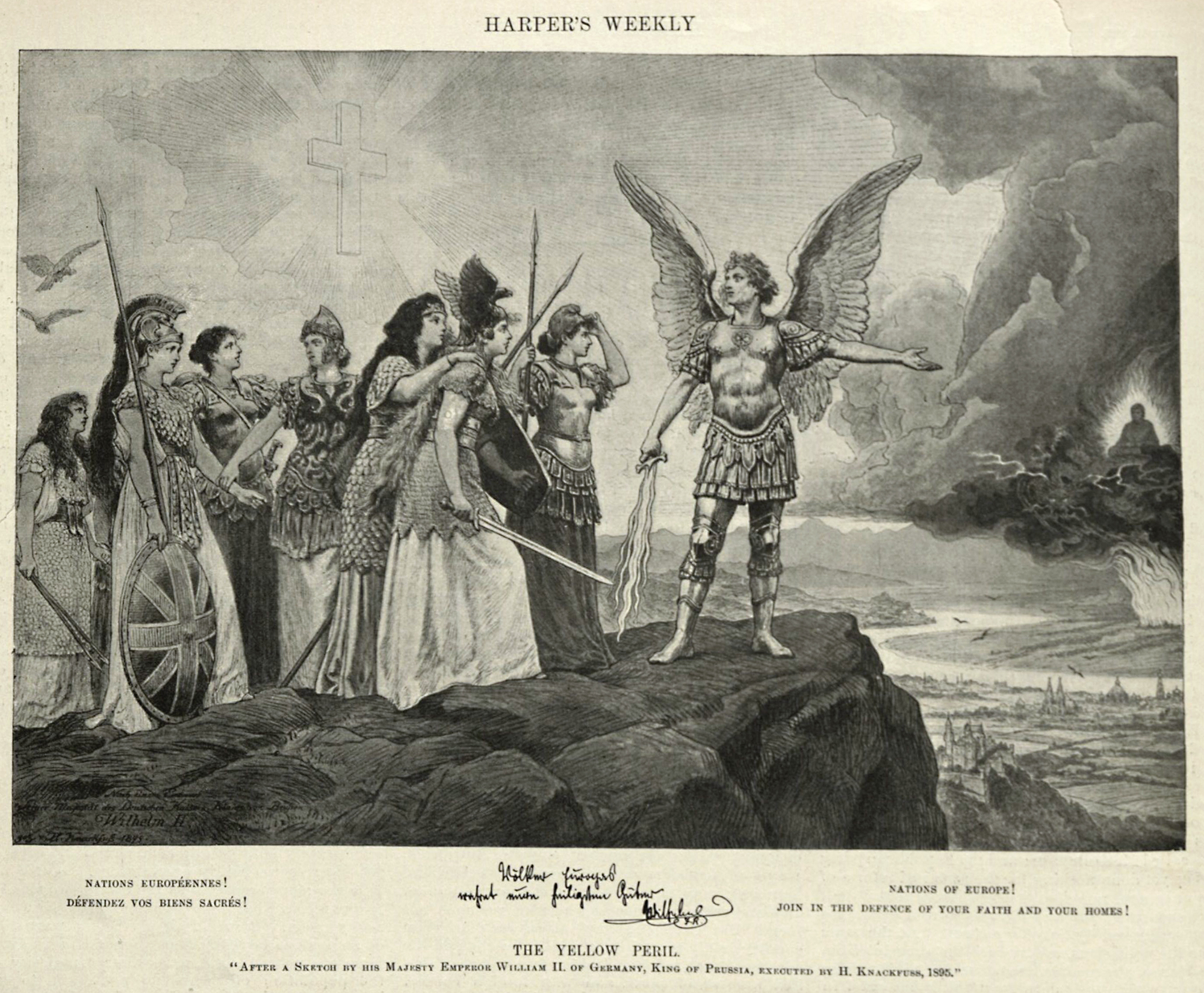
| "The Yellow Peril." Caption (translation): "Peoples of Europe, Defend Your Holiest Possessions" This famous "Yellow Peril" lithograph by the German artist Hermann Knackfuss was based on a drawing by his patron, Kaiser Wilhelm II, in 1895 and widely disseminated thereafter. The version reproduced here appeared three years later, on the eve of the Boxer uprising, in the January 22, 1898 issue of the American magazine Harper's Weekly. |
| Yellow Peril imagery proved irresistible to political cartoonists throughout the West, often enhanced by the new phenomenon of mass-circulation color printing. In July 1900, at the peak of the Boxer uprising, for example, cartoonists in both Italy and Switzerland used the color yellow dramatically to essentially echo the animus of Wilhelm's lithograph (which was black and white) and thereby intensify evocation of the racial dimension of the menace of the Orient. In the Italian case, the West is personified by a female figure surrounded by European soldiers and waving the flag of "Civilization" (Civilta). She points to the East (as the archangel Michael had done in Wilhelm's graphic), where the gigantic leering yellow face of a Chinaman looms on the horizon. |
| "Petits, Suivez mon Étendard." (Youth, Take Up My Flag) Published in Turin in the magazine Pasquino, July 15, 1900 The caption to this Italian "Yellow Peril" cartoon translates as follows: "Come, strike the barbarian all united in my name and you will overcome... Strike with the same vigor with which he has struck you!" Source: "Chinois d'Europe et Chinois d'Asie," undated archival album of cartoons collected by John Grand-Carteret [Grand-Carteret_38a_YELLOW_bpt6k63508640] |
| In the Swiss variant of this racist cartooning, an abstract Europe occupies center stage in the form of a delicate maiden holding the dove of peace with an olive branch in its beak. Here, the Yellow Peril takes the form of a monstrous dragon labeled China, which merges into collapsing walls behind which flames lick the sky. To the right of the maiden, foreign militaries led by the Russian bear, the French cock, and the German eagle stand poised to take on the yellow monster. In the distance behind her stand small figures representing foreign leaders—with "America" conspicuously detached and looking on. The left foreground of the graphic introduces a striking additional dimension to the scene in the form of the British lion standing over an armed white corpse identified as "Transvaal," one of the two Dutch settler states in colonial South Africa that rebelled against British rule. This refers to England's concurrent war against white colonialists of Dutch descent in the Second Boer War (1899–1902) in South Africa. Like American political cartoons that depict the United States engaged in asserting dominion over Cuba, Puerto Rico, and the Philippines at the very same time that "carving up the Chinese pie" was taking place, this Swiss graphic is a reminder of the global frenzy of war and imperialism at the turn of the century. |
| "La Paix Européenne. " (The European Peace) Caption (translation): "The end of the beginning, beginning of the end. — Europe holds in her arms the dove with olive branch and wonders about the fate of this poor little weakling." The writing on the cloud under the Peace figure reads: "The poor child is delicate and tender; what will be her fate?" Published in the Zurich periodical Nebelspalter, July 7, 1900 Artist: F. Boscovitz Source: "Chinois d'Europe et Chinois d'Asie," undated archival album of cartoons collected by John Grand-Carteret [Grand-Carteret_38b_YELLOW_bpt6k63508640] |
| Cartoon commentary in the Yellow Peril genre was, however, far from monolithic. Christian contempt for and fear of the heathen masses of Asia, as seen most explicitly in Kaiser Wilhelm's presentation of the Cross versus the Buddha, was only one of its dimensions. Plain color-coded racism pervaded the Italian and Swiss graphics, but at the same time, other artists gleefully turned Wilhelm's alarmism on its head. In 1896, for example, a Berlin publication ridiculed the original Yellow Peril lithograph with a satirical take-off in which a winged Wilhelm himself replaces the archangel Michael, the feminized nations of Europe are replaced by the Kaiser's own male ministers, the iron cross of Prussian militarism replaces the Christian cross in the sky, and the ominous Buddha on the distant horizon has metamorphosed into a Chinese statesman (referring explicitly to Li Hongzhang, the preeminent Chinese diplomat of the time). |
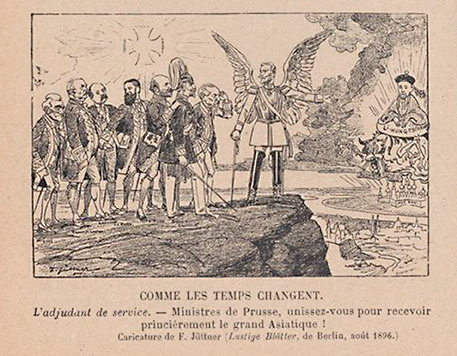
| Translation: "How Times Change! The adjutant announces, — Ministers of Prussia, come together to welcome honorably the great Asian minister!" Lustige Blätter, Berlin, August 1896 Artist: F. Jüttner Source: "Chinois d'Europe et Chinois d'Asie,"undated archival album of cartoons collected by John Grand-Carteret [Grand-Carteret_22b_LIHUNGCHANG_bpt6k63508640] |
| Another German periodical subjected the Kaiser's alarmism to even more caustic ridicule. In this rendering, the whole thrust of the putative Europe/Orient confrontation has been turned into a commercial enterprise. Archangel Michael has metamorphosed into a silly rendering, naked but for a fig leaf, of the Roman god Mercury—the patron deity (among other things) of commerce, financial profits, travelers, boundaries, trickery, and thieves. Wilhelm's Buddha, the ominous anti-Christ, has been replaced by a Chinese merchant or politician surrounded by bags of coins. The billowing black clouds of the original lithograph now clearly emanate from factory smokestacks, and the feminine personifications of European nations all clutch projected exports to the envisioned China market. And what has replaced the shining Christian cross in Wilhelm's heaven? A glittering sack of gold (or money, or profits). This satirical cartoon was titled "Mercury Addresses the European Powers," followed by a parody of Wilhelm's original caption that reads (in translation) as follows: "The enemy from the east approaches, and you rush to meet him to do battle. Peoples of Europe, sell him your most valuable commodities!" Although in this instance the explicit take-off on the original gelbe Gefahr lithograph was unique, the underlying observation was not. The reason expansionist foreign powers were intent on carving China into spheres of influence was, after all, their perception that untold profits would derive from this. This glittering sack of gold was, indeed, the other side of the "yellow peril." |
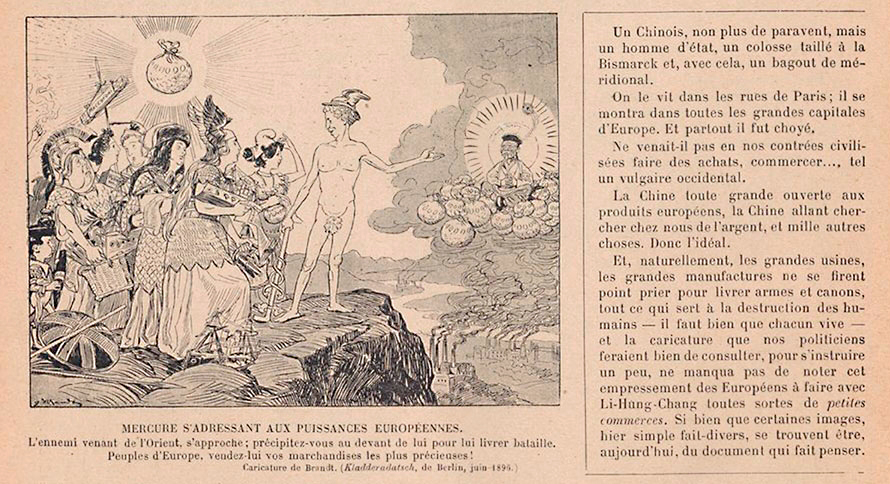
| "Mercury Addresses the European Powers" Kladderadatsch, Berlin, June 1895 Artist: Brandt This satirical take-off on Wilhelm II's notorious lithograph, published in Berlin, turns the Kaiser's Christian demonology into an invitation to exploit the potential riches of the China market. Source: "Chinois d'Europe et Chinois d'Asie," undated archivalalbum of cartoons collected by John Grand-Carteret [Grand-Carteret_22a_LIHUNGCHANG_bpt6k63508640] |
| In 1900, at the height of foreign condemnation of the Boxer uprising, the Kaiser's iconic lithograph was subjected to yet another lively transmutation. The artist in this instance was Johann Braakensick, a Dutch cartoonist publishing in Amsterdam. His revisionist target was explicitly stated in the title of the cartoon: "A New Interpretation of Kaiser Wilhelm's Picture." And his iconoclasm was thoroughgoing—for he completely inverted the original format of Europeans gazing at a threatening Asia. In Braaakensick's striking graphic, it is China and the peoples of Asia who stand on a headland and behold a threatening West in the form of a huge warship. The Christian cross remains in this rendering, albeit relocated above the warship. Archangel Michael has been replaced by the great Chinese sage Confucius (who also holds a sword). The female personifications of European nations have been replaced by female figures in various Asian native costumes—suggesting that China leads the multiple peoples and races of the Orient. A flying dragon rides the heavens where Wilhelm had placed his Christian cross. And as if all this were not "new interpretation" enough, the sub-caption has Confucius exhorting: "Peoples of Asia, protect your sacred possessions." |
| "A New Interpretation of Kaiser Wilhelm's Picture" Published in Weekblad vor Nederland, June 24, 1900 Artist: Johann Braakensick This iconoclastic cartoon, published in Amsterdam at the height of the Boxer uprising in 1900, dramatically turns Wilhelm II's famous lithograph upside down. The point of view is Asian rather than Prussian, and the looming peril is Western warships sailing under the Christian cross. Source: "Chinois d'Europe et Chinois d'Asie," undated archivalalbum of cartoons collected by John Grand-Carteret [Grand-Carteret_34_GelbeGefahr_bpt6k63508640] |
| While this Dutch cartoon was unique in its direct and explicit reversal of the original "Yellow Peril" lithograph, the underlying critical perspective was, once again, not exceptional. Racist Yellow Peril imagery was indeed ubiquitous in Western publications in these turn-of-the-century years. It became even more hysterical when Japan proceeded to defeat (white and Christian) Imperial Russia in the Russo-Japanese War of 1904 to 1905. At the same time, however, the revolutionary new world of publications aimed at mass audiences—and the new levels of international stimulation and cross-fertilization this helped expedite—also encouraged a diversity of outlooks. The imperialist foreign powers were the very opposite of monolithic, and harmonious in their attitudes and ambitions. And the new world of literally graphic political commentary ranged across a spectrum from flat-out racist ideologues and imperialists to incisive (and witty) anti-imperialists like Johann Braaksick in Amsterdam. The latter—and they were not few in number—were able to imagine how Asians might look at the world and reasonably see a truly threatening "White Peril." |
| |
Source: https://visualizingcultures.mit.edu/boxer_uprising/bx_essay02.html
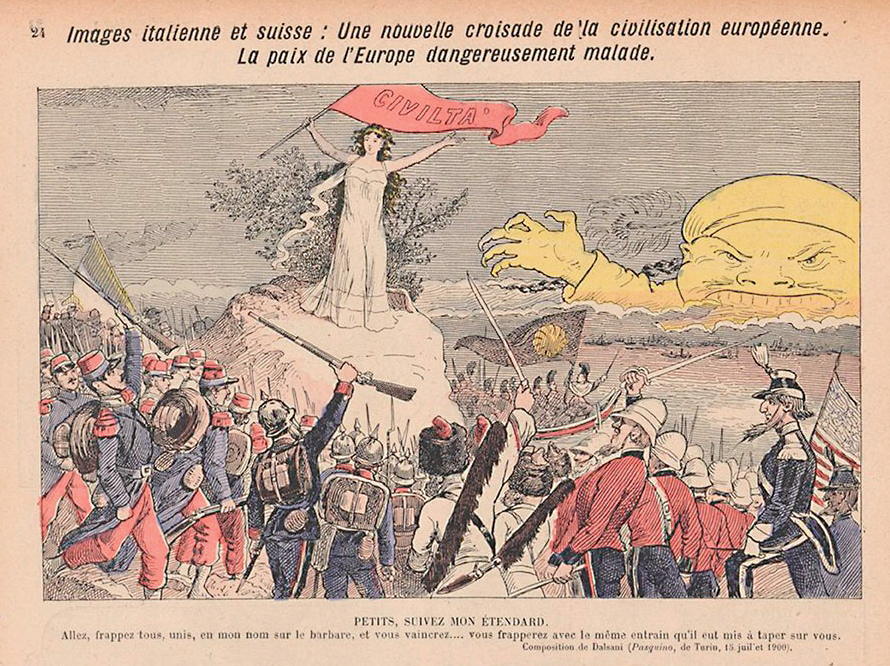
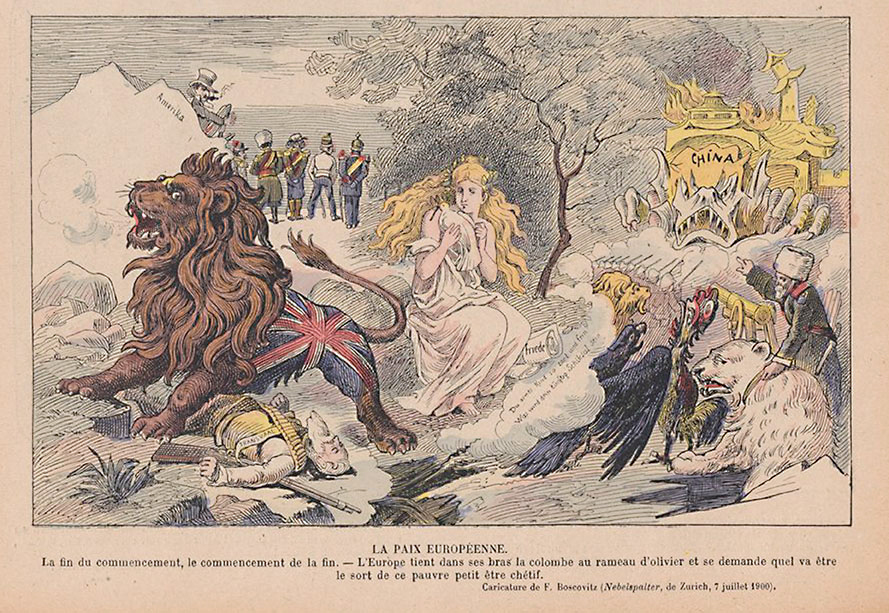
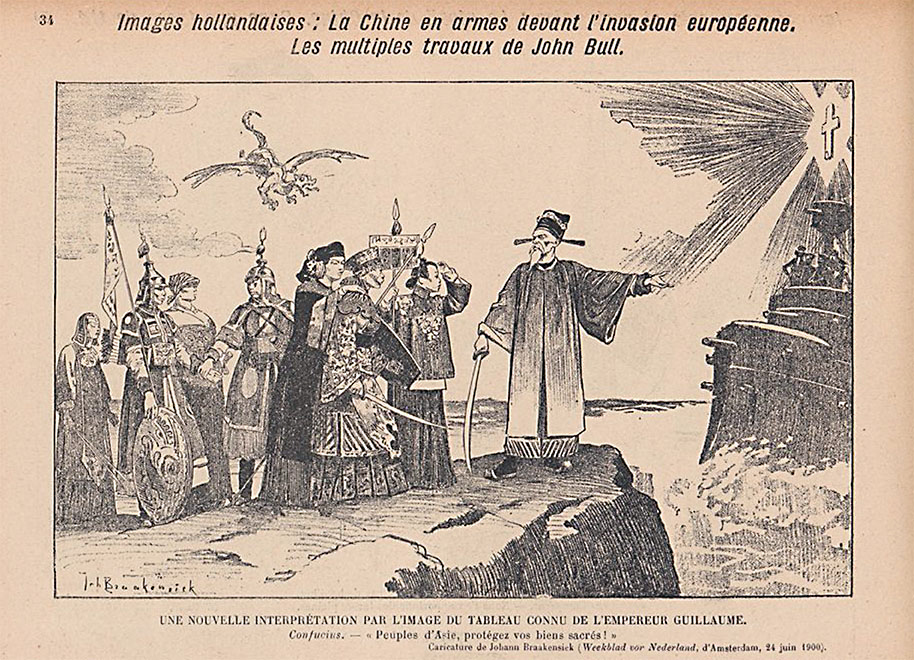
0 Response to "Political Cartoon Transcontinental Railroad Funny Political Cartoons Transcontinental Railroad"
Enviar um comentário